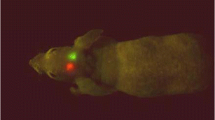Abstract
An optical luminescent microscope has been developed to monitor the behavior of tumor cells that were modified by GFP and RFP fluorescent proteins and to monitor the formation of metastases in biochips. Images of cells in the light of GFP and RFP fluorescence proteins, as well as in the photography mode, are recorded in the microscope by an noncooled CMOS matrix at the excitation of luminescence by blue and green LEDs and illumination of cells with white LEDs, respectively. The obtained fluorescent images and photos in white light are recorded by the matrix in the same coordinate system and do not require additional processing for combination. The power of irradiation of cells with LEDs does not exceed 50 μW/mm2 at an exposure time of 1 s, which is an order of magnitude lower than the radiation power causing photodestruction and phototoxicity of cells during long-term studies. Relative parameters of the optical channel of the luminescent microscope have been introduced that allow comparing the sensitivity of the recording system and the minimum power level of the radiation that excites luminescence for optical elements with different spectral characteristics.
Similar content being viewed by others
References
R. Dixit and R. Cyr, Plant J. 36, 280 (2003). doi 10.1046/j.1365-313X.2003.01868.x
H. Schneckenburger, P. Weber, M. Wagner, T. Bruns, V. Richte, S. Schickinger, and R. Wittig, Photon. Lasers Med. 1, 35 (2012). doi 10.1515/plm-2011-0011
M. M. Frigault, J. Lacoste, J. L. Swift, and C. M. Brown, J. Cell Sci. 122, 753 (2009). doi 10.1242/jcs.033837
B. R. Masters and T. C. So Peter, Opt. Express 8, 2 (2001). doi 10.1364/OE.8.000002
M. R. Tsai, S. Y. Chen, D. B. Shieh, P. J. Lou, and C. K. Sun, Biomed. Opt. Express 2, 2317 (2011). doi 10.1364/BOE.2.002317
L. V. Doronina-Amitonova, I. V. Fedotov, A. B. Fedotov, K. V. Anokhin, and A. M. Zheltikov, Phys. Usp. 58, 345 (2015). doi 10.3367/UFNr.0185.201504c.0371
N. M. M. Pires, T. Dong, U. Hanke, and N. Hoivik, Sensors 14, 15458 (2014). doi 10.3390/s140815458
T. R. Samatov, M. U. Shkurnikov, S. A. Tonevitskaya, and A. G. Tonevitsky, Progr. Histochem. Cytochem. 49, 21 (2015). doi 10.1016/j.proghi.2015.01.001
J. Wiedenmann, F. Oswald, and G. U. Nienhaus, Life 61, 1029 (2009). doi 10.1002/iub.256
D. M. Chudakov, M. V. Matz, S. Lukyanov, and K. A. Lukyanov, Physiol. Rev. 90, 1103 (2010). doi 10.1152/physrev.00038.2009
https://doi.org/www.stormoff.ru/fluorescentnaya-mikroskopiya1/
P. Gautam, A. Recino, R. D. Foale, J. Zhao, S. U. Gan, M. Wallberg, R. Calne, and A. Lever, J. Gene Med. 18, 312 (2016). doi 10.1002/jgm.2900
H. Schneckenburger, P. Weber, M. Wagner, S. Schickinger, V. Richter, T. Bruns, W. S. L. Strauss, and R. Witting, J. Microsc. 245, 311 (2012). doi 10.1111/ j.1365-2818.2011.03576.x
Z. Schilling, E. Frank, V. Magidson, J. Wason, J. Lončarek, K. Boyer, J. Wen, and A. Khodjakov, J. Microsc. 246, 160 (2012). doi 10.1111/j.1365-2818.2012.03605.x
https://doi.org/evrogen.ru/protein-descriptions/TurboGFPdescription.pdf
A. A. Poloznikov, A. A. Zakhariants, S. V. Nikulin, N. A. Smirnova, D. M. Hushpulian, I. N. Gaisina, A. G. Tonevitsky, V. I. Tishkov, and I. G. Gazaryan, Biochimie 133, 74 (2016). doi 10.1016/j.biochi. 2016.12.004
Author information
Authors and Affiliations
Corresponding author
Additional information
Original Russian Text © K.A. Fomicheva, O.V. Kindeeva, V.A. Petrov, A.A. Ivanov, A.A. Poloznikov, B.Ya. Alekseev, M.Yu. Shkurnikov, 2018, published in Optika i Spektroskopiya, 2018, Vol. 125, No. 1, pp. 129–136.
Rights and permissions
About this article
Cite this article
Fomicheva, K.A., Kindeeva, O.V., Petrov, V.A. et al. Features of Construction of the Fluorescent Microscope for the Study of Epithelial-Mesenchymal Transition of Cells in Vitro. Opt. Spectrosc. 125, 137–143 (2018). https://doi.org/10.1134/S0030400X18070093
Received:
Accepted:
Published:
Issue Date:
DOI: https://doi.org/10.1134/S0030400X18070093




